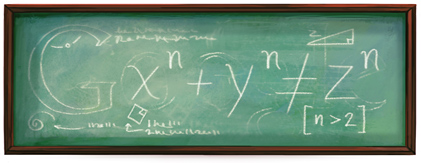Fermat's Last Theorem states that
x^n + y^n = z^n has no non-zero integer solutions for x, y and z when n > 2
"I have discovered a truly marvelous proof of this theorem, which this doodle is too small to contain."
Pierre de Fermat's birthday celebrated in Google Doodle
The birthday of Pierre de Fermat, the 17th century French lawyer famous for the so-called 'Fermat's Last Theorem' mathematical puzzle, is celebrated in a Google Doodle today.
http://www.telegraph.co.uk/technology/google/google-doodle/8706390/Pierre-de-Fermats-birthday-celebrated-in-Google-Doodle.html
Pierre de Fermat's Last Theorem celebrated in a cheeky Google doodle
Today's Google doodle is apparently too small to contain the proof of Fermat's Last Theorem
http://www.guardian.co.uk/science/blog/2011/aug/17/pierre-de-fermat-theorem-google-doodle
Google Doodle Celebrates 410th Birthday of Mathematician Pierre de Fermat
Google is celebrating what would have been the 410th birthday of mathematician Pierre de Fermat with a homepage doodle that transforms the company's logo into a complex math problem.
http://www.pcmag.com/article2/0,2817,2391245,00.asp
Fermat eWorkshop :
Practice Fermat Number 1
http://www.cemc.uwaterloo.ca/contests/pcf_eWorkshop/FermatPracticeOne.pdf
Practice Fermat Number 2
http://www.cemc.uwaterloo.ca/contests/pcf_eWorkshop/FermatPracticeTwo.pdf
Practice Fermat Number 3
http://www.cemc.uwaterloo.ca/contests/pcf_eWorkshop/FermatPracticeThree.pdf
Practice Fermat Number 4
http://www.cemc.uwaterloo.ca/contests/pcf_eWorkshop/FermatPracticeFour.pdf
Interesting problem (#25): Fermat Test 2010 question
http://www.cemc.uwaterloo.ca/contests/past_contests/2010/2010FermatContest.pdf
Alex chose positive number, a,b,c,d,e,f, and completely multiplied out the polynomial product
(1-x)^a (1+x)^b (1-x+x^2)^c (1+x^2)^d (1+x+x^2)^e (1+x+x^2+x^3+x^4)^f
After she simplified her result, she discarded any term involving x to any power larger than 6 and was astonished to see that what was left was (1-2x) .If a>d+e+f and b>c+d and e>c,
what value of a did she chose?
a.17, b.19,c.20,d.21,e.23
Solution: See problem #25
http://cemc.uwaterloo.ca/contests/past_contests/2010/2010FermatSolution.pdf


No comments:
Post a Comment